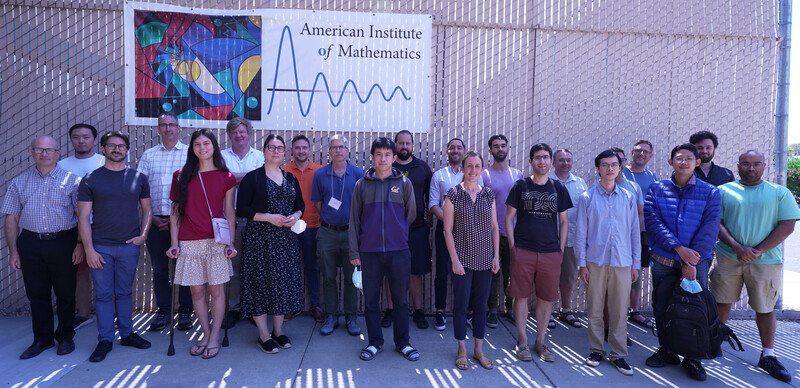Geometry and physics of ALX metrics in gauge theory
July 25 to July 29, 2022
at the
American Institute of Mathematics,
San Jose, California
organized by
Laura Fredrickson,
Akos Nagy,
Steven Rayan,
and Hartmut Weiss
Original Announcement
This workshop will be devoted to the geometric features and physical interpretations
of certain 4-dimensional metrics arising from equations in gauge
theory.
These 4-dimensional metrics are classically known within the
differential geometry community as ALE, ALF, ALG, and ALH gravitational
instantons and their generalizations. There are four important families
of noncompact, complete Riemannian 4-manifolds, called Asymptotically
Locally Euclidean or ALE, Asymptotically Locally Flat or ALF, ALG, and
ALH (the last two named unimaginatively via induction). While the
precise definition of these spaces vary by authors, they are always
noncompact 4-manifolds with fibered ends. More precisely, the
dimensions of the fiber are 0 (ALE), 1 (ALF), 2 (ALG), and 3 (ALH). The
size of the fibers is bounded, and the volume growth of the manifold is
$r^{4-\dim (\mathrm{fiber})}$. An ALX space (where X = E, F, G, or H)
is called a gravitational instanton if it is hyperkähler and satisfies
certain curvature decay requirements. A quasi-ALX or QALX space (where
X = E, F, of G) is a higher-dimensional generalization of an ALX space
where certain singular behaviors are allowed.
These spaces have central roles in low-dimensional gauge theories. Over
the past thirty years, moduli spaces of vector bundles, monopoles,
vortices, flat connections, and Higgs bundles have been incredibly
influential in geometry. In particular, Higgs bundles have been studied
in differential geometry, mathematical physics, and even in number
theory through its connections to the Langlands program. The $L^2$
geometry of the Hitchin moduli spaces corresponding to closed Riemann
surfaces is still a topic of intense research. For example, the
asymptotics of the Hitchin metric have just recently been rigorously
established. The end of the Hitchin moduli is a singular torus
fibration, and, in fact, it is conjectured to be a QALG space with
respect to this fibration.
It is still unclear what the appropriate generalization of Hitchin's
equations is in higher dimensions. One candidate in 4D is the
Kapustin--Witten equations. These are a family of equations
parametrized by a real number $\theta \in [0, \pi)$. It is easy to see
that if the underlying 4-manifold is closed and $\theta \neq 0,
\tfrac{\pi}{2}$, then the Kapustin--Witten equations do not have
interesting, smooth solutions. Thus one needs to consider noncompact
manifolds or singular solutions. Natural choices for noncompact
4-manifolds are the ALE, ALF, ALG, and ALH spaces. Taubes has
considered the ALE case recently. Furthermore, there have been projects
studying noncompact manifolds with cylindrical ends and with singular
boundary conditions. Beyond these results, little is known even about
the analytic properties of these solutions and the geometry of moduli
spaces over different manifolds.
The main topics are:
-
Verify that the $L^2$-metric on the Higgs bundle
moduli space is QALG. It has long been a folklore expectation that
the natural hyperkähler metric on the moduli space of Higgs
bundles is quasi-ALG. The global properties of the metric are at
the heart of a number of conjectures related, for instance, to the
convergence of certain path integrals from physics defined over the
moduli space. Recent results establish some asymptotics of the
metric, at least in low rank away from certain ''bad'' loci.
However, there is still no one-size-fits-all analytic approach to
understanding the asymptotics of the Hitchin metric. In particular,
we wish to understand the nature of the metric nearby to the
discriminant locus of the moduli space.
- Kapustin--Witten equations on closed Kähler surfaces
and ALX manifolds. As mentioned in the introduction, very little
is known about Kapustin--Witten fields on closed manifolds, and on
ALX spaces. We propose here the start of the study of such
problems. More concretely, we propose looking at the cases when the
underlying manifold, $X$, is either a closed Kähler surface, or an
ALX manifold (a ''gravitational instanton''). As a first step, the
group could establish basic existence and vanishing results. For
example, using dimensional reduction, one can construct solution
with spherical symmetry, when $X$ is a product of a closed surface
and $\mathbb{P}^1$ (in which case the Kapustin--Witten equation
reduces to Manton's five vortex equations). Furthermore, Taubes'
result gives some insight to flat factors of $\mathbb{R}^4$, which
are examples of (flat) ALX manifolds. Thus, building on Taubes
theorem, one might be able to prove nonexistence of nontrivial
solutions in those cases.
- Hitchin--Kobayashi correspondence for the
Kapustin--Witten equations. Over compact Kähler surfaces, the
structure of the $\theta = 0$ Kapustin--Witten equations can be
interpreted similarly to Hitchin's equations: a pair of equations
consisting of a moment map equation on the curvature and the
harmonicity of the Higgs field. It follows that Kapustin--Witten
moduli embed into the moduli space of Higgs bundles (holomorphic
bundles with endomorphism-valued holomorphic 1-forms) over the
Kähler surface. We propose investigating the properties of this
embedding, mainly whether it has an inverse under certain
circumstances. In some instances, Hitchin--Kobayashi-style
correspondences have been obtained for reduced Kapustin-Witten
equations on noncompact 3-manifolds; the extent to which this is
true in general (and for the nonreduced case) is a key problem in
complex gauge theory. \item Other problems to discuss may include
noncollapsed limits of Einstein $4$-manifolds, which are Einstein
orbifolds with ALE bubbles. The question of which of these
orbifolds can be desingularized or obtained as a limit is open. On
the other hand, there are open questions in ALF geometry related to
collapsed limits.
Material from the workshop
A list of participants.
The workshop schedule.
A report on the workshop activities.
A list of open problems.
Workshop Videos
Papers arising from the workshop:

